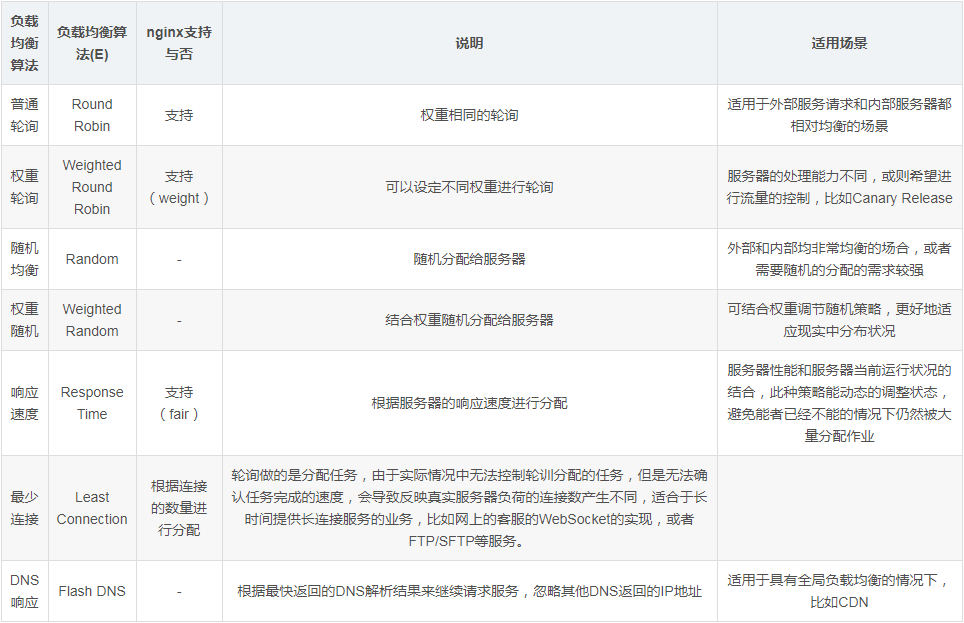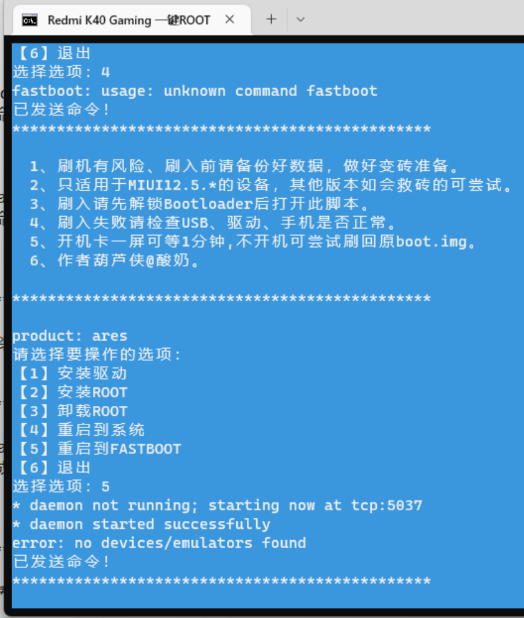四层负载均衡 vs 七层负载均衡
经常会说七层负载均衡还是四层负载均衡,其实根据iso的osi网络模型的所在层的叫法而决定的,nginx因为在使用http协议在应用层进行负载均衡的操作,所以被称为七层负载均衡。而诸如lvs在tcp层进行负载均衡操作的则被称为四层负载均衡。一般来说,有如下层的负载均衡分类:

常见软件的支持

常见的负载均衡算法
负载均衡常见有如下几种算法:

负载均衡演示实例:普通轮询
接下来使用nginx来演示一下如何进行普通轮询:

事前准备
事前在7001/7002两个端口分别启动两个服务,用于显示不同信息,为了演示方便,使用tornado做了一个镜像,通过docker容器启动时传递的参数不同用于显示服务的不同。
[root@kong ~]# docker run -d -p 7001:8080 liumiaocn/tornado:latest python /usr/local/bin/daemon.py "user service 1: 7001" ddba0abd24524d270a782c3fab907f6a35c0ce514eec3159357bded09022ee57 [root@kong ~]# docker run -d -p 7002:8080 liumiaocn/tornado:latest python /usr/local/bin/daemon.py "user service 1: 7002" 95deadd795e19f675891bfcd44e5ea622c95615a95655d1fd346351eca707951 [root@kong ~]# [root@kong ~]# curl http://192.168.163.117:7001 hello, service :user service 1: 7001 [root@kong ~]# [root@kong ~]# curl http://192.168.163.117:7002 hello, service :user service 1: 7002 [root@kong ~]#
启动nginx
[root@kong ~]# docker run -p 9080:80 --name nginx-lb -d nginx 9d53c7e9a45ef93e7848eb3f4e51c2652a49681e83bda6337c89a3cf2f379c74 [root@kong ~]# docker ps |grep nginx-lb 9d53c7e9a45e nginx "nginx -g 'daemon ..." 11 seconds ago up 10 seconds 0.0.0.0:9080->80/tcp nginx-lb [root@kong ~]#
nginx代码段
准备如下nginx代码段将其添加到nginx的/etc/nginx/conf.d/default.conf中
http { upstream nginx_lb { server 192.168.163.117:7001; server 192.168.163.117:7002; } server { listen 80; server_name www.liumiao.cn 192.168.163.117; location / { proxy_pass http://nginx_lb; } }
修改default.conf的方法
可以通过在容器中安装vim达到效果,也可以在本地修改然后通过docker cp传入,或者直接sed修改都可。如果在容器中安装vim,使用如下方式即可
[root@kong ~]# docker exec -it nginx-lb sh # apt-get update ...省略 # apt-get install vim ...省略
修改前
# cat default.conf server { listen 80; server_name localhost; #charset koi8-r; #access_log /var/log/nginx/host.access.log main; location / { root /usr/share/nginx/html; index index.html index.htm; } #error_page 404 /404.html; # redirect server error pages to the static page /50x.html # error_page 500 502 503 504 /50x.html; location = /50x.html { root /usr/share/nginx/html; } # proxy the php scripts to apache listening on 127.0.0.1:80 # #location ~ .php$ { # proxy_pass http://127.0.0.1; #} # pass the php scripts to fastcgi server listening on 127.0.0.1:9000 # #location ~ .php$ { # root html; # fastcgi_pass 127.0.0.1:9000; # fastcgi_index index.php; # fastcgi_param script_filename /scripts$fastcgi_script_name; # include fastcgi_params; #} # deny access to .htaccess files, if apache's document root # concurs with nginx's one # #location ~ /.ht { # deny all; #} } #
修改后
# cat default.conf upstream nginx_lb { server 192.168.163.117:7001; server 192.168.163.117:7002; } server { listen 80; server_name www.liumiao.cn 192.168.163.117; #charset koi8-r; #access_log /var/log/nginx/host.access.log main; location / { #root /usr/share/nginx/html; #index index.html index.htm; proxy_pass http://nginx_lb; } #error_page 404 /404.html; # redirect server error pages to the static page /50x.html # error_page 500 502 503 504 /50x.html; location = /50x.html { root /usr/share/nginx/html; } # proxy the php scripts to apache listening on 127.0.0.1:80 # #location ~ .php$ { # proxy_pass http://127.0.0.1; #} # pass the php scripts to fastcgi server listening on 127.0.0.1:9000 # #location ~ .php$ { # root html; # fastcgi_pass 127.0.0.1:9000; # fastcgi_index index.php; # fastcgi_param script_filename /scripts$fastcgi_script_name; # include fastcgi_params; #} # deny access to .htaccess files, if apache's document root # concurs with nginx's one # #location ~ /.ht { # deny all; #} } #
重启nginx容器
[root@kong ~]# docker restart nginx-lb nginx-lb [root@kong ~]#
确认结果
可以清晰地看到按照顺序,进行轮询:
[root@kong ~]# curl
hello, service :user service 1: 7001
[root@kong ~]# curl
hello, service :user service 1: 7002
[root@kong ~]# curl
hello, service :user service 1: 7001
[root@kong ~]# curl
hello, service :user service 1: 7002
[root@kong ~]#
负载均衡演示实例:权重轮询
而在此基础上,进行权重轮询只需要加上weight即可

修改default.conf
按照如下修改default.conf
# cp default.conf default.conf.org # vi default.conf # diff default.conf default.conf.org 2,3c2,3 server 192.168.163.117:7001; > server 192.168.163.117:7002; #
重启nginx容器
[root@kong ~]# docker restart nginx-lb nginx-lb [root@kong ~]#
确认结果
可以看到轮询结果按照1/3和2/3的比重在进行了:
[root@kong ~]# curl
hello, service :user service 1: 7001
[root@kong ~]# curl
hello, service :user service 1: 7002
[root@kong ~]# curl
hello, service :user service 1: 7002
[root@kong ~]#
















